Attached files
| file | filename |
|---|---|
| 8-K - FORM 8-K - Walmart Inc. | form8-kx5182017.htm |
| EX-99.1 - PRESS RELEASE - Walmart Inc. | earningsrelease-4302017.htm |


Safe harbor and non-GAAP measures
This presentation contains statements as to Walmart management's guidance regarding earnings per share for the three months ending July 31, 2017, Walmart U.S.'s comparable sales and Sam's Club's comparable sales, excluding fuel, for the 13-week
period ending July 28, 2017 and the third-party FCPA- and compliance- related expenses expected to be incurred for year ending January 31, 2018. Assumptions on which such forward-looking statements are based, including without limitation
assumptions regarding our effective tax rate for the year ending January 31, 2018, are also forward-looking statements. Walmart believes such statements are "forward-looking statements" as defined in, and are intended to enjoy the protection of the safe
harbor for such statements provided by, the Private Securities Litigation Reform Act of 1995, as amended. Walmart's actual results may differ materially from the guidance provided as a result of changes in circumstances, assumptions not being realized
or other risks, uncertainties and factors including:
• economic, geo-political, capital markets and business conditions, trends and events around the world and in the markets in which Walmart operates;
• currency exchange rate fluctuations, changes in market interest rates and commodity prices;
• unemployment levels;
• competitive pressures;
• inflation or deflation, generally and in particular product categories;
• consumer confidence, disposable income, credit availability, spending levels, shopping patterns, debt levels and demand for certain merchandise;
• consumer enrollment in health and drug insurance programs and such programs' reimbursement rates;
• the amount of Walmart's net sales denominated in the U.S. dollar and various foreign currencies;
• the financial performance of Walmart and each of its segments;
• Walmart's ability to successfully integrate acquired businesses, including within the e-commerce space;
• Walmart's effective tax rate and the factors affecting Walmart's effective tax rate, including assessments of certain tax contingencies, valuation allowances, changes in law, administrative audit outcomes, impact of discrete items and the mix of earnings
between the U.S. and Walmart's international operations;
• customer traffic and average ticket in Walmart's stores and clubs and on its e-commerce websites;
• the mix of merchandise Walmart sells, the cost of goods it sells and the shrinkage it experiences;
• the amount of Walmart's total sales and operating expenses in the various markets in which it operates;
• transportation, energy and utility costs and the selling prices of gasoline and diesel fuel;
• supply chain disruptions and disruptions in seasonal buying patterns;
• consumer acceptance of and response to Walmart's stores, clubs, e-commerce websites, mobile apps, initiatives, programs and merchandise offerings;
• cyber security events affecting Walmart and related costs;
• developments in, outcomes of, and costs incurred in legal or regulatory proceedings to which Walmart is a party;
• casualty and accident-related costs and insurance costs;
• the turnover in Walmart's workforce and labor costs, including healthcare and other benefit costs;
• changes in accounting estimates or judgments;
• changes in existing tax, labor and other laws and regulations and changes in tax rates, trade agreements, trade restrictions and tariff rates;
• the level of public assistance payments;
• natural disasters, public health emergencies, civil disturbances, and terrorist attacks; and
• Walmart's expenditures for FCPA and other compliance related costs.
Such risks, uncertainties and factors also include the risks relating to Walmart's strategy, operations and performance and the financial, legal, tax, regulatory, compliance and other risks discussed in Walmart's most recent annual report on Form 10-K filed
with the SEC. You should read this presentation in conjunction with that annual report on Form 10-K and Walmart's subsequently filed current reports on Form 8-K. You should consider all of the risks, uncertainties and other factors identified above and in
those SEC reports carefully when evaluating the forward looking statements in this presentation. Walmart cannot assure you that the future results reflected in or implied by any such forward-looking statement will be realized or, even if substantially
realized, will have the forecasted or expected consequences and effects for or on Walmart's operations or financial performance. Such forward-looking statements are made as of the date of this presentation, and Walmart undertakes no obligation to
update such statements to reflect subsequent events or circumstances.
This presentation includes certain non-GAAP measures as defined under SEC rules, including net sales, revenue, and operating income on a constant currency basis, comp sales excluding fuel, free cash flow and return on investment. Refer to
information about the non-GAAP measures contained in this presentation. Additional information as required by Regulation G and Item 10(e) of Regulation S-K regarding non-GAAP measures can be found in our most recent Form 10-K and our Form 8-K
furnished as of the date of this presentation with the SEC, which are available at www.stock.walmart.com.
2
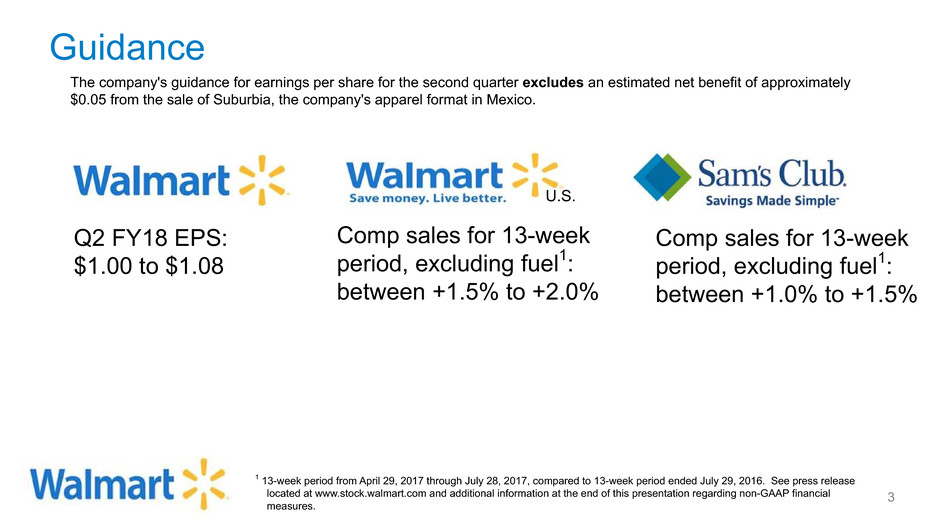
Q2 FY18 EPS:
$1.00 to $1.08
Comp sales for 13-week
period, excluding fuel1:
between +1.5% to +2.0%
Comp sales for 13-week
period, excluding fuel1:
between +1.0% to +1.5%
1 13-week period from April 29, 2017 through July 28, 2017, compared to 13-week period ended July 29, 2016. See press release
located at www.stock.walmart.com and additional information at the end of this presentation regarding non-GAAP financial
measures.
Guidance
3
The company's guidance for earnings per share for the second quarter excludes an estimated net benefit of approximately
$0.05 from the sale of Suburbia, the company's apparel format in Mexico.
U.S.
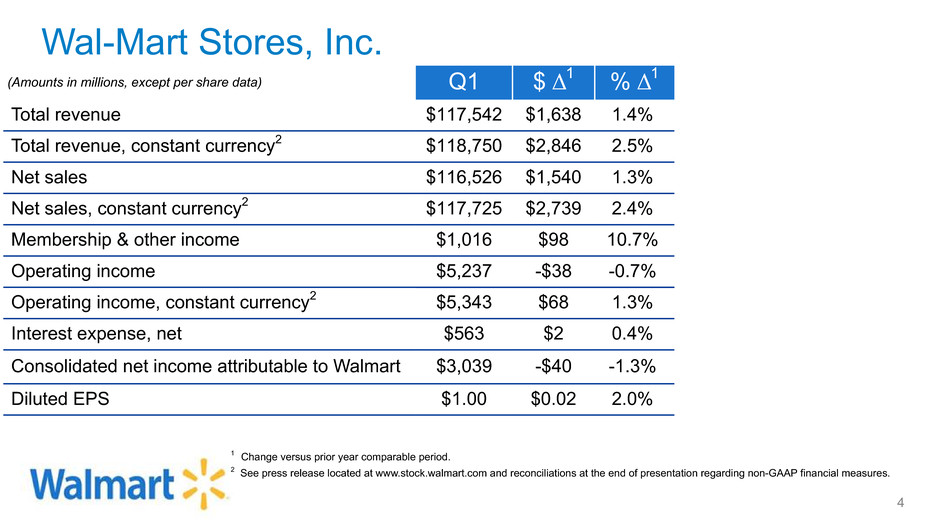
Wal-Mart Stores, Inc.
(Amounts in millions, except per share data) Q1 $ Δ1 % Δ1
Total revenue $117,542 $1,638 1.4%
Total revenue, constant currency2 $118,750 $2,846 2.5%
Net sales $116,526 $1,540 1.3%
Net sales, constant currency2 $117,725 $2,739 2.4%
Membership & other income $1,016 $98 10.7%
Operating income $5,237 -$38 -0.7%
Operating income, constant currency2 $5,343 $68 1.3%
Interest expense, net $563 $2 0.4%
Consolidated net income attributable to Walmart $3,039 -$40 -1.3%
Diluted EPS $1.00 $0.02 2.0%
1 Change versus prior year comparable period.
2 See press release located at www.stock.walmart.com and reconciliations at the end of presentation regarding non-GAAP financial measures.
4

Wal-Mart Stores, Inc.
Q1 bps Δ1
Gross profit rate 24.8% 1 bps
Operating expenses as a percentage of net
sales 21.1% 18 bps
Effective tax rate 32.6% 78 bps
Debt to total capitalization2 38.7% -130 bps
Return on investment3,4 15.1% -20 bps
1 Basis points change versus prior year comparable period.
2 Debt to total capitalization is calculated as of April 30, 2017. Debt includes short-term borrowings, long-term debt due within one
year, capital lease and financing obligations due within one year, long-term debt, and long-term capital lease and financing
obligations. Total capitalization includes debt and total Walmart shareholders' equity.
3 ROI is calculated for the trailing 12 months ended April 30, 2017.
4 See reconciliations at the end of presentation regarding non-GAAP financial measures.
5
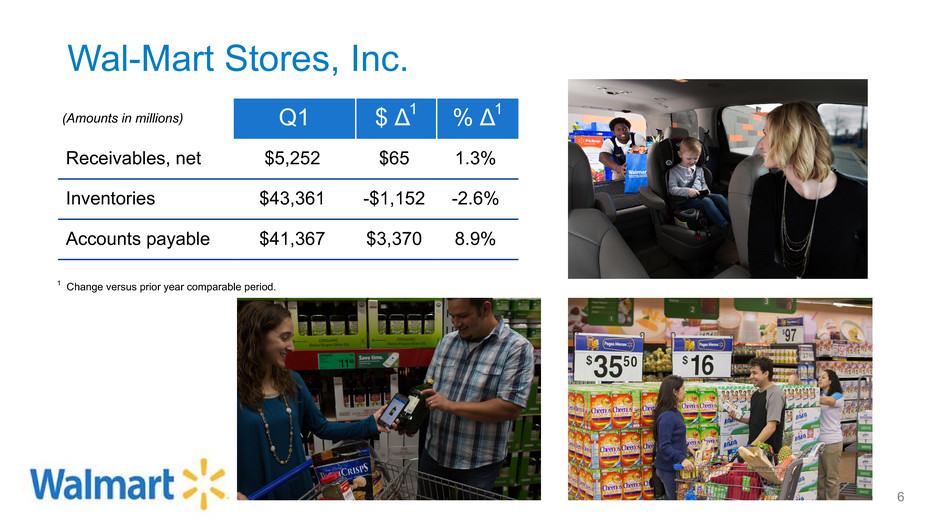
(Amounts in millions) Q1 $ Δ1 % Δ1
Receivables, net $5,252 $65 1.3%
Inventories $43,361 -$1,152 -2.6%
Accounts payable $41,367 $3,370 8.9%
Wal-Mart Stores, Inc.
1 Change versus prior year comparable period.
6

Wal-Mart Stores, Inc.
(Amounts in millions) Q1 $ Δ1
Operating cash flow $5,385 -$808
Capital expenditures $1,990 -$219
Free cash flow2 $3,395 -$589
(Amounts in millions) Q1 % Δ1
Dividends $1,549 -1.5%
Share repurchases3 $2,185 -20.1%
Total $3,734 -13.3%
1 Change versus prior year comparable period.
2 See press release located at www.stock.walmart.com and reconciliations at the end of this presentation regarding non-
GAAP financial measures.
3 $7.0 billion remaining of $20 billion authorization approved in October 2015. 7
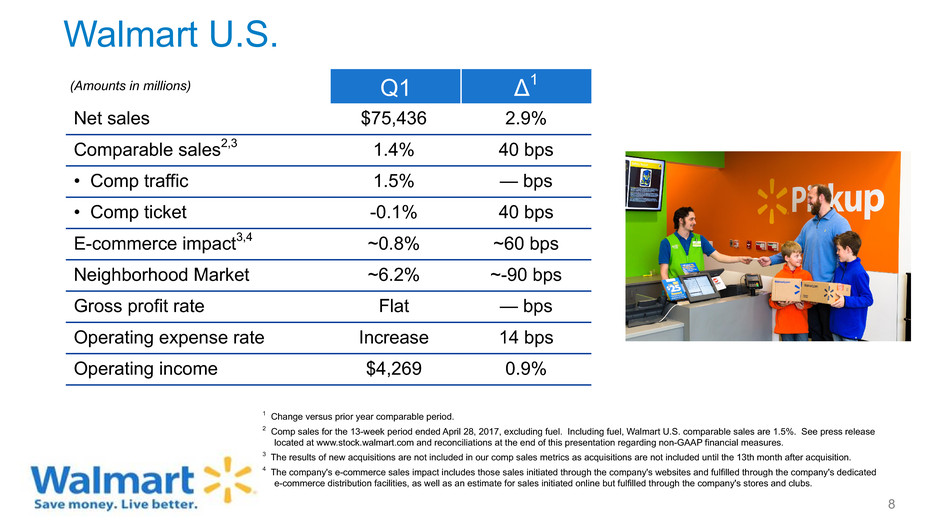
Walmart U.S.
(Amounts in millions) Q1 Δ1
Net sales $75,436 2.9%
Comparable sales2,3 1.4% 40 bps
• Comp traffic 1.5% — bps
• Comp ticket -0.1% 40 bps
E-commerce impact3,4 ~0.8% ~60 bps
Neighborhood Market ~6.2% ~-90 bps
Gross profit rate Flat — bps
Operating expense rate Increase 14 bps
Operating income $4,269 0.9%
1 Change versus prior year comparable period.
2 Comp sales for the 13-week period ended April 28, 2017, excluding fuel. Including fuel, Walmart U.S. comparable sales are 1.5%. See press release
located at www.stock.walmart.com and reconciliations at the end of this presentation regarding non-GAAP financial measures.
3 The results of new acquisitions are not included in our comp sales metrics as acquisitions are not included until the 13th month after acquisition.
4 The company's e-commerce sales impact includes those sales initiated through the company's websites and fulfilled through the company's dedicated
e-commerce distribution facilities, as well as an estimate for sales initiated online but fulfilled through the company's stores and clubs.
8
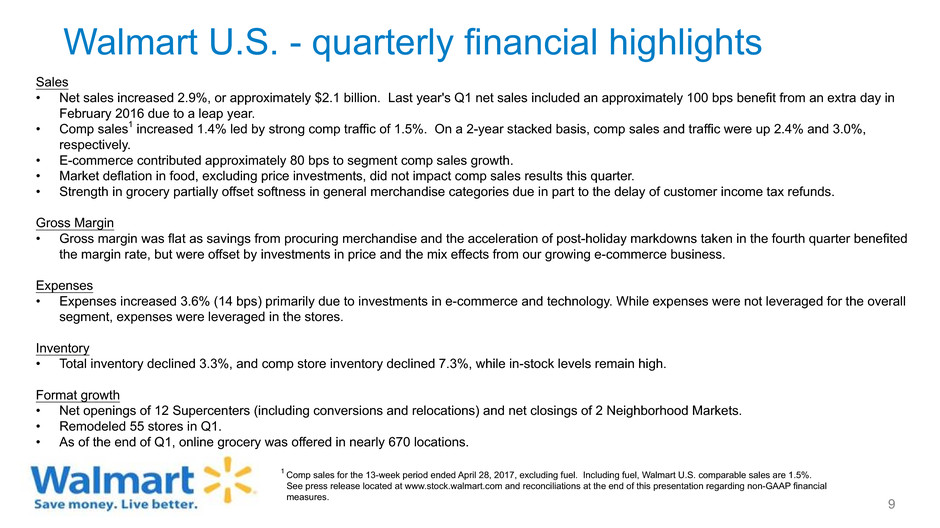
Walmart U.S. - quarterly financial highlights
9
Sales
• Net sales increased 2.9%, or approximately $2.1 billion. Last year's Q1 net sales included an approximately 100 bps benefit from an extra day in
February 2016 due to a leap year.
• Comp sales1 increased 1.4% led by strong comp traffic of 1.5%. On a 2-year stacked basis, comp sales and traffic were up 2.4% and 3.0%,
respectively.
• E-commerce contributed approximately 80 bps to segment comp sales growth.
• Market deflation in food, excluding price investments, did not impact comp sales results this quarter.
• Strength in grocery partially offset softness in general merchandise categories due in part to the delay of customer income tax refunds.
Gross Margin
• Gross margin was flat as savings from procuring merchandise and the acceleration of post-holiday markdowns taken in the fourth quarter benefited
the margin rate, but were offset by investments in price and the mix effects from our growing e-commerce business.
Expenses
• Expenses increased 3.6% (14 bps) primarily due to investments in e-commerce and technology. While expenses were not leveraged for the overall
segment, expenses were leveraged in the stores.
Inventory
• Total inventory declined 3.3%, and comp store inventory declined 7.3%, while in-stock levels remain high.
Format growth
• Net openings of 12 Supercenters (including conversions and relocations) and net closings of 2 Neighborhood Markets.
• Remodeled 55 stores in Q1.
• As of the end of Q1, online grocery was offered in nearly 670 locations.
1 Comp sales for the 13-week period ended April 28, 2017, excluding fuel. Including fuel, Walmart U.S. comparable sales are 1.5%.
See press release located at www.stock.walmart.com and reconciliations at the end of this presentation regarding non-GAAP financial
measures.

Walmart U.S. - quarterly merchandise highlights
Category Comp Comments
Grocery1 + low single-digit
Traffic in food and consumables accelerated throughout the quarter,
including a strong Easter performance; market deflation in food,
excluding price investments, did not impact comp sales results in Q1.
Health & wellness + low single-digit Continued solid comp traffic across pharmacy and OTC. Brandeddrug inflation and pharmacy script growth favorably impacted sales.
General
merchandise2 - low single-digit
Sales were sluggish at the start of the quarter with delayed customer
income tax refund checks and the timing of post-holiday markdowns
that collectively impacted higher ticket and discretionary purchases.
Sales improved throughout the quarter and finished with a strong
Easter.
1 Includes food and consumables.
2 General merchandise includes entertainment, toys, hardlines, apparel and home/seasonal. 10
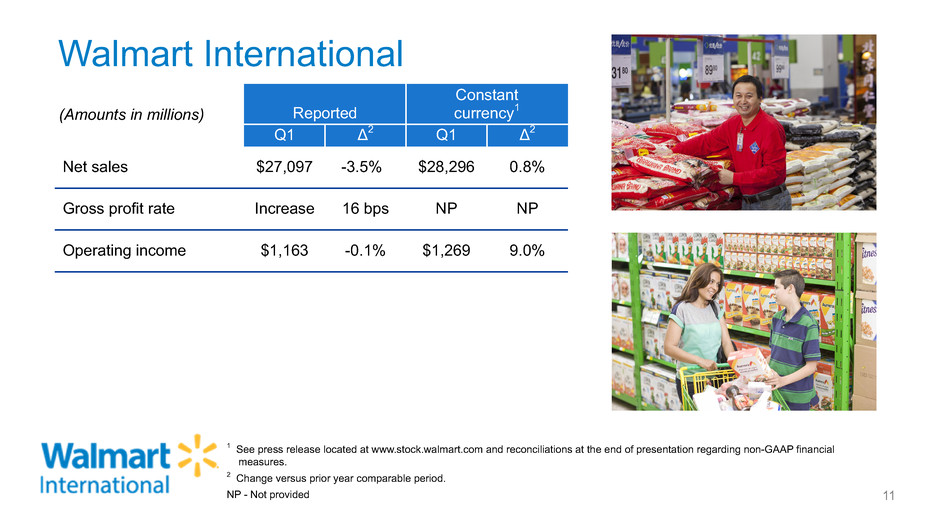
Walmart International
1
(Amounts in millions) Reported
Constant
currency1
Q1 Δ2 Q1 Δ2
Net sales $27,097 -3.5% $28,296 0.8%
Gross profit rate Increase 16 bps NP NP
Operating income $1,163 -0.1% $1,269 9.0%
1 See press release located at www.stock.walmart.com and reconciliations at the end of presentation regarding non-GAAP financial
measures.
2 Change versus prior year comparable period.
NP - Not provided 11
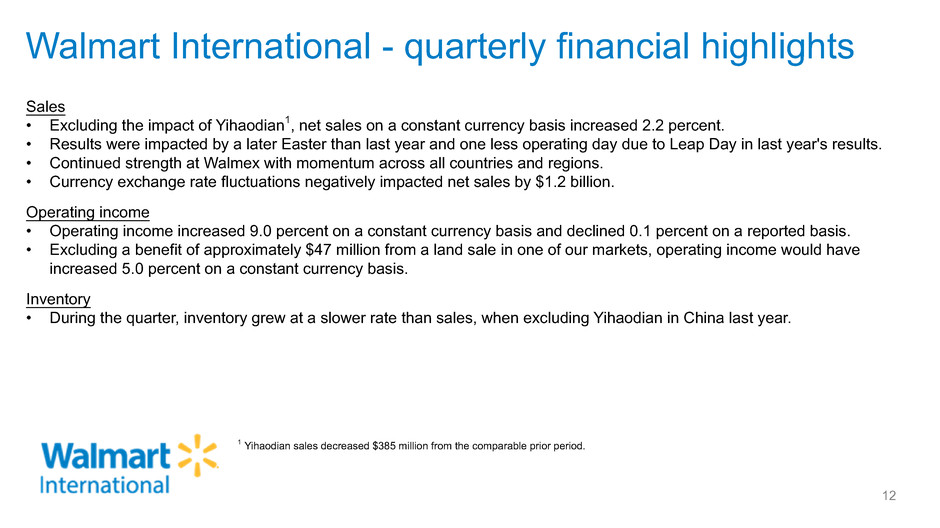
Walmart International - quarterly financial highlights
12
Sales
• Excluding the impact of Yihaodian1, net sales on a constant currency basis increased 2.2 percent.
• Results were impacted by a later Easter than last year and one less operating day due to Leap Day in last year's results.
• Continued strength at Walmex with momentum across all countries and regions.
• Currency exchange rate fluctuations negatively impacted net sales by $1.2 billion.
Operating income
• Operating income increased 9.0 percent on a constant currency basis and declined 0.1 percent on a reported basis.
• Excluding a benefit of approximately $47 million from a land sale in one of our markets, operating income would have
increased 5.0 percent on a constant currency basis.
Inventory
• During the quarter, inventory grew at a slower rate than sales, when excluding Yihaodian in China last year.
1 Yihaodian sales decreased $385 million from the comparable prior period.

Walmart International - key markets quarterly results
1 Results are on a constant currency basis. Net sales and comp sales are presented on a nominal, calendar basis.
2 E-commerce results included for the United Kingdom, Walmex, Canada and China.
3 Change versus prior year comparable period. Results were impacted by a later Easter than last year and one less operating day
due to Leap Day in last year's results.
4 Comp sales for the United Kingdom are presented excluding fuel.
5 Walmex includes the consolidated results of Mexico and Central America.
6 Excludes the impact of Yihaodian.
Country1,2
Comp3 Net
sales3
Gross
profit
rate3
Operating
income3Sales Traffic Ticket
United Kingdom4 -2.8% -2.0% -0.8% 0.9% Decrease Decrease
Walmex5 3.7% -1.2% 4.9% 5.2% Increase Increase3¹
Canada 1.5% -0.7% 2.2% 2.7% Decrease Decrease
China6 -1.3% -4.1% 2.8% 0.7% Increase Increase
13
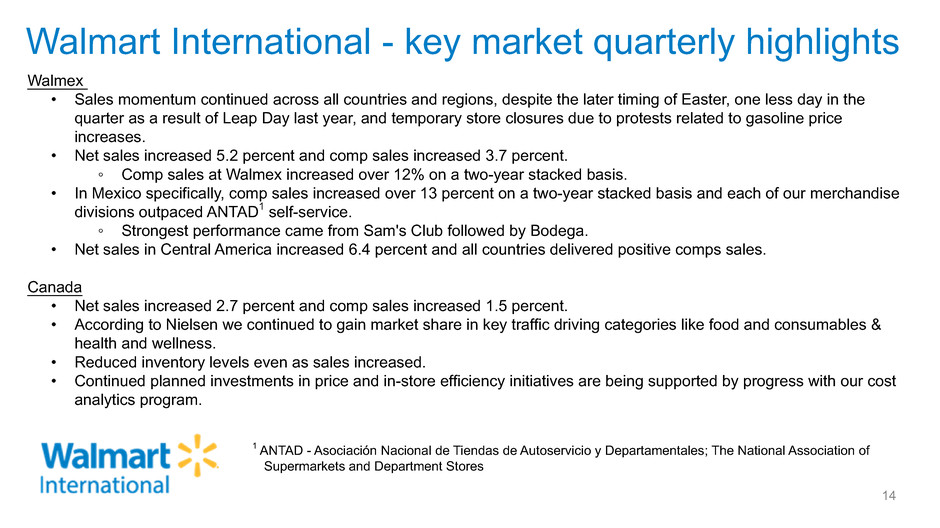
Walmart International - key market quarterly highlights
14
Walmex
• Sales momentum continued across all countries and regions, despite the later timing of Easter, one less day in the
quarter as a result of Leap Day last year, and temporary store closures due to protests related to gasoline price
increases.
• Net sales increased 5.2 percent and comp sales increased 3.7 percent.
◦ Comp sales at Walmex increased over 12% on a two-year stacked basis.
• In Mexico specifically, comp sales increased over 13 percent on a two-year stacked basis and each of our merchandise
divisions outpaced ANTAD1 self-service.
◦ Strongest performance came from Sam's Club followed by Bodega.
• Net sales in Central America increased 6.4 percent and all countries delivered positive comps sales.
Canada
• Net sales increased 2.7 percent and comp sales increased 1.5 percent.
• According to Nielsen we continued to gain market share in key traffic driving categories like food and consumables &
health and wellness.
• Reduced inventory levels even as sales increased.
• Continued planned investments in price and in-store efficiency initiatives are being supported by progress with our cost
analytics program.
1 ANTAD - Asociación Nacional de Tiendas de Autoservicio y Departamentales; The National Association of
Supermarkets and Department Stores
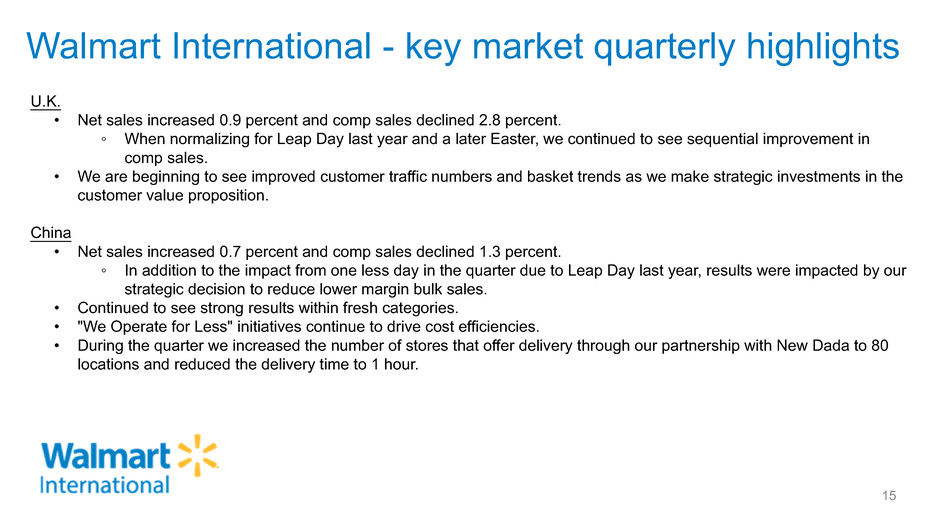
Walmart International - key market quarterly highlights
15
U.K.
• Net sales increased 0.9 percent and comp sales declined 2.8 percent.
◦ When normalizing for Leap Day last year and a later Easter, we continued to see sequential improvement in
comp sales.
• We are beginning to see improved customer traffic numbers and basket trends as we make strategic investments in the
customer value proposition.
China
• Net sales increased 0.7 percent and comp sales declined 1.3 percent.
◦ In addition to the impact from one less day in the quarter due to Leap Day last year, results were impacted by our
strategic decision to reduce lower margin bulk sales.
• Continued to see strong results within fresh categories.
• "We Operate for Less" initiatives continue to drive cost efficiencies.
• During the quarter we increased the number of stores that offer delivery through our partnership with New Dada to 80
locations and reduced the delivery time to 1 hour.
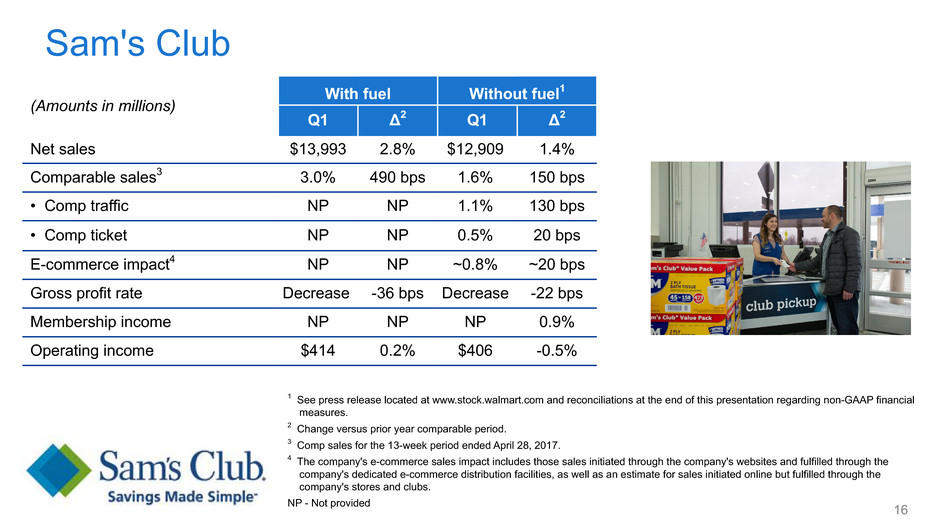
Sam's Club
(Amounts in millions)
With fuel Without fuel1
Q1 Δ2 Q1 Δ2
Net sales $13,993 2.8% $12,909 1.4%
Comparable sales3 3.0% 490 bps 1.6% 150 bps
• Comp traffic NP NP 1.1% 130 bps
• Comp ticket NP NP 0.5% 20 bps
E-commerce impact4 NP NP ~0.8% ~20 bps
Gross profit rate Decrease -36 bps Decrease -22 bps
Membership income NP NP NP 0.9%
Operating income $414 0.2% $406 -0.5%
1 See press release located at www.stock.walmart.com and reconciliations at the end of this presentation regarding non-GAAP financial
measures.
2 Change versus prior year comparable period.
3 Comp sales for the 13-week period ended April 28, 2017.
4 The company's e-commerce sales impact includes those sales initiated through the company's websites and fulfilled through the
company's dedicated e-commerce distribution facilities, as well as an estimate for sales initiated online but fulfilled through the
company's stores and clubs.
NP - Not provided 16
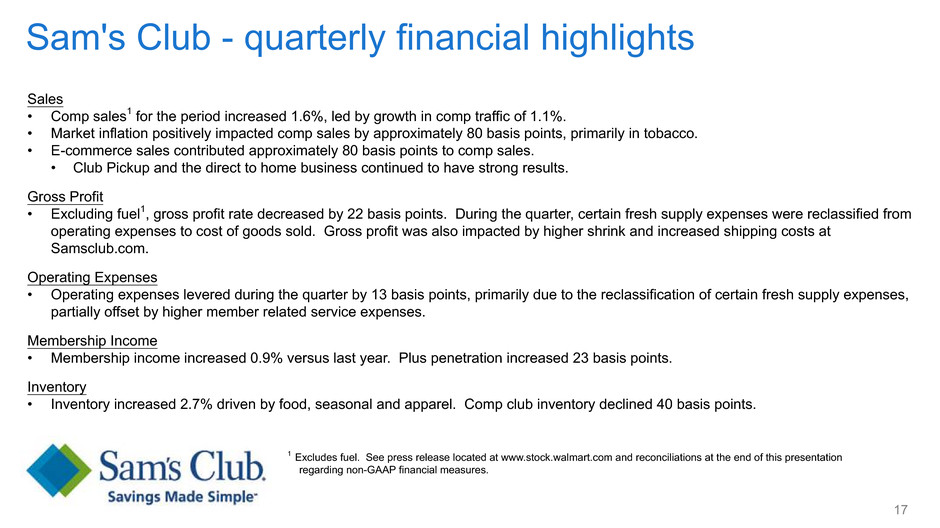
Sam's Club - quarterly financial highlights
17
Sales
• Comp sales1 for the period increased 1.6%, led by growth in comp traffic of 1.1%.
• Market inflation positively impacted comp sales by approximately 80 basis points, primarily in tobacco.
• E-commerce sales contributed approximately 80 basis points to comp sales.
• Club Pickup and the direct to home business continued to have strong results.
Gross Profit
• Excluding fuel1, gross profit rate decreased by 22 basis points. During the quarter, certain fresh supply expenses were reclassified from
operating expenses to cost of goods sold. Gross profit was also impacted by higher shrink and increased shipping costs at
Samsclub.com.
Operating Expenses
• Operating expenses levered during the quarter by 13 basis points, primarily due to the reclassification of certain fresh supply expenses,
partially offset by higher member related service expenses.
Membership Income
• Membership income increased 0.9% versus last year. Plus penetration increased 23 basis points.
Inventory
• Inventory increased 2.7% driven by food, seasonal and apparel. Comp club inventory declined 40 basis points.
1 Excludes fuel. See press release located at www.stock.walmart.com and reconciliations at the end of this presentation
regarding non-GAAP financial measures.
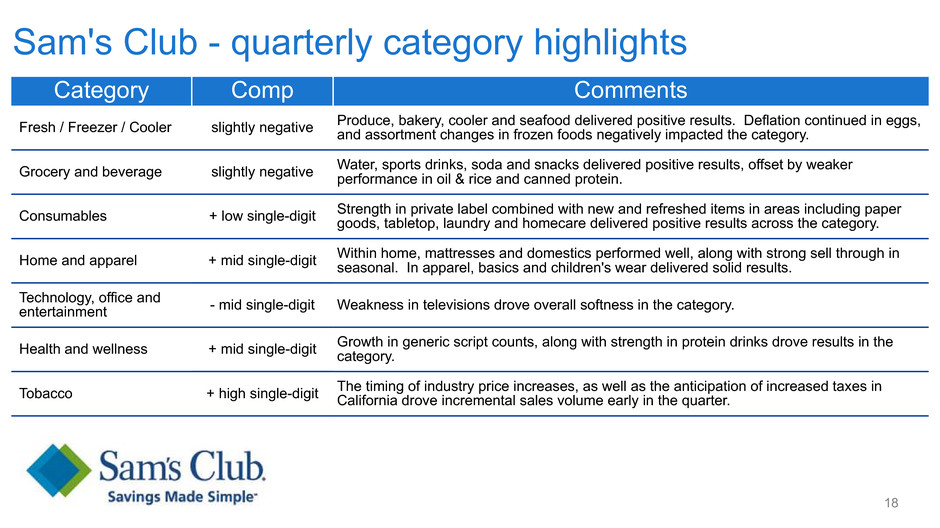
Sam's Club - quarterly category highlights
18
Category Comp Comments
Fresh / Freezer / Cooler slightly negative Produce, bakery, cooler and seafood delivered positive results. Deflation continued in eggs,and assortment changes in frozen foods negatively impacted the category.
Grocery and beverage slightly negative Water, sports drinks, soda and snacks delivered positive results, offset by weakerperformance in oil & rice and canned protein.
Consumables + low single-digit Strength in private label combined with new and refreshed items in areas including papergoods, tabletop, laundry and homecare delivered positive results across the category.
Home and apparel + mid single-digit Within home, mattresses and domestics performed well, along with strong sell through inseasonal. In apparel, basics and children's wear delivered solid results.
Technology, office and
entertainment - mid single-digit Weakness in televisions drove overall softness in the category.
Health and wellness + mid single-digit Growth in generic script counts, along with strength in protein drinks drove results in thecategory.
Tobacco + high single-digit The timing of industry price increases, as well as the anticipation of increased taxes inCalifornia drove incremental sales volume early in the quarter.
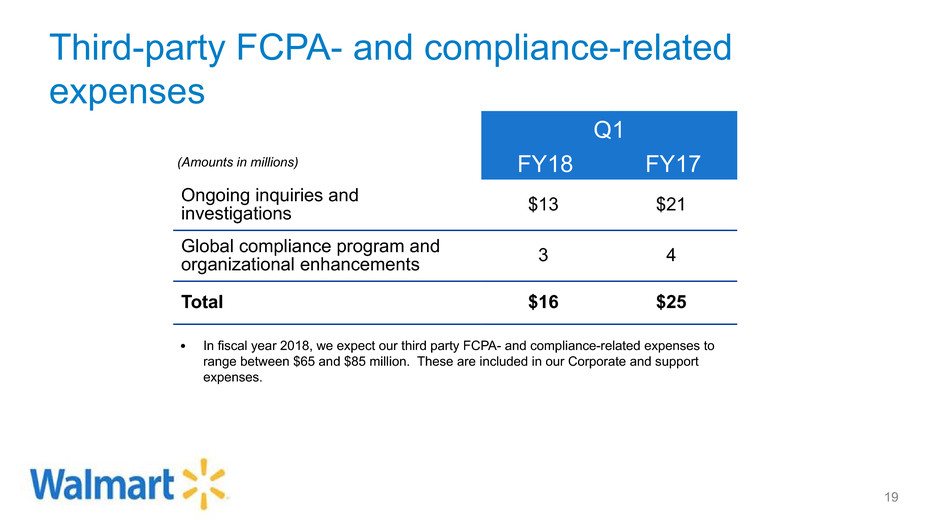
Third-party FCPA- and compliance-related
expenses
Q1
(Amounts in millions) FY18 FY17
Ongoing inquiries and
investigations $13 $21
Global compliance program and
organizational enhancements 3 4
Total $16 $25
• In fiscal year 2018, we expect our third party FCPA- and compliance-related expenses to
range between $65 and $85 million. These are included in our Corporate and support
expenses.
19
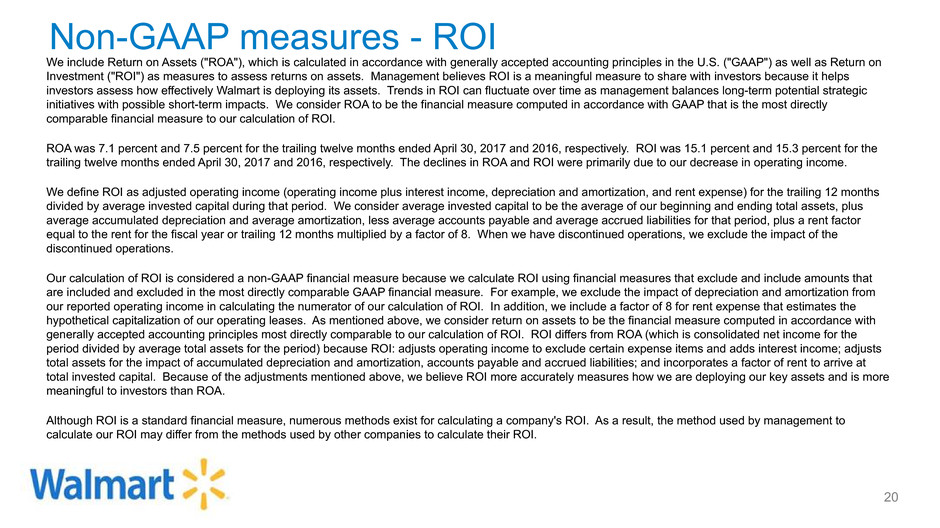
Non-GAAP measures - ROI
We include Return on Assets ("ROA"), which is calculated in accordance with generally accepted accounting principles in the U.S. ("GAAP") as well as Return on
Investment ("ROI") as measures to assess returns on assets. Management believes ROI is a meaningful measure to share with investors because it helps
investors assess how effectively Walmart is deploying its assets. Trends in ROI can fluctuate over time as management balances long-term potential strategic
initiatives with possible short-term impacts. We consider ROA to be the financial measure computed in accordance with GAAP that is the most directly
comparable financial measure to our calculation of ROI.
ROA was 7.1 percent and 7.5 percent for the trailing twelve months ended April 30, 2017 and 2016, respectively. ROI was 15.1 percent and 15.3 percent for the
trailing twelve months ended April 30, 2017 and 2016, respectively. The declines in ROA and ROI were primarily due to our decrease in operating income.
We define ROI as adjusted operating income (operating income plus interest income, depreciation and amortization, and rent expense) for the trailing 12 months
divided by average invested capital during that period. We consider average invested capital to be the average of our beginning and ending total assets, plus
average accumulated depreciation and average amortization, less average accounts payable and average accrued liabilities for that period, plus a rent factor
equal to the rent for the fiscal year or trailing 12 months multiplied by a factor of 8. When we have discontinued operations, we exclude the impact of the
discontinued operations.
Our calculation of ROI is considered a non-GAAP financial measure because we calculate ROI using financial measures that exclude and include amounts that
are included and excluded in the most directly comparable GAAP financial measure. For example, we exclude the impact of depreciation and amortization from
our reported operating income in calculating the numerator of our calculation of ROI. In addition, we include a factor of 8 for rent expense that estimates the
hypothetical capitalization of our operating leases. As mentioned above, we consider return on assets to be the financial measure computed in accordance with
generally accepted accounting principles most directly comparable to our calculation of ROI. ROI differs from ROA (which is consolidated net income for the
period divided by average total assets for the period) because ROI: adjusts operating income to exclude certain expense items and adds interest income; adjusts
total assets for the impact of accumulated depreciation and amortization, accounts payable and accrued liabilities; and incorporates a factor of rent to arrive at
total invested capital. Because of the adjustments mentioned above, we believe ROI more accurately measures how we are deploying our key assets and is more
meaningful to investors than ROA.
Although ROI is a standard financial measure, numerous methods exist for calculating a company's ROI. As a result, the method used by management to
calculate our ROI may differ from the methods used by other companies to calculate their ROI.
20
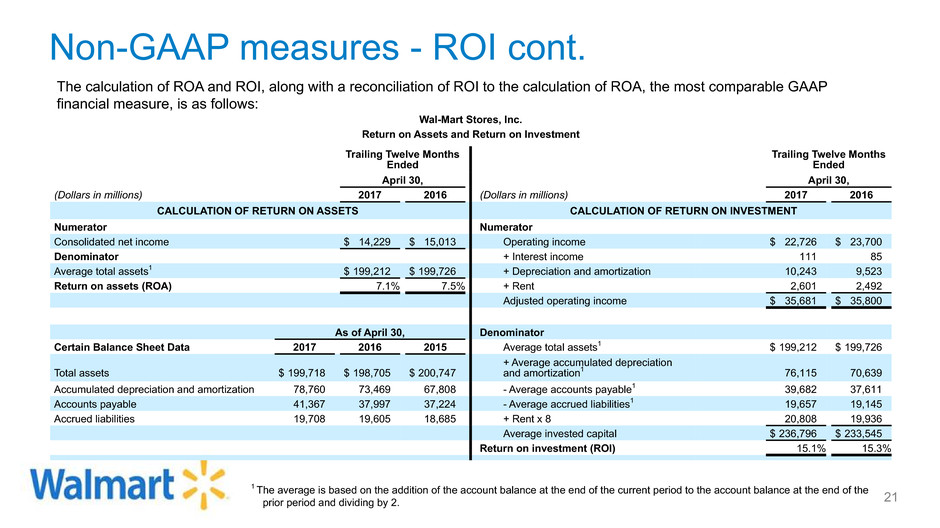
Non-GAAP measures - ROI cont.
The calculation of ROA and ROI, along with a reconciliation of ROI to the calculation of ROA, the most comparable GAAP
financial measure, is as follows:
Wal-Mart Stores, Inc.
Return on Assets and Return on Investment
Trailing Twelve Months
Ended
Trailing Twelve Months
Ended
April 30, April 30,
(Dollars in millions) 2017 2016 (Dollars in millions) 2017 2016
CALCULATION OF RETURN ON ASSETS CALCULATION OF RETURN ON INVESTMENT
Numerator Numerator
Consolidated net income $ 14,229 $ 15,013 Operating income $ 22,726 $ 23,700
Denominator + Interest income 111 85
Average total assets1 $ 199,212 $ 199,726 + Depreciation and amortization 10,243 9,523
Return on assets (ROA) 7.1% 7.5% + Rent 2,601 2,492
Adjusted operating income $ 35,681 $ 35,800
As of April 30, Denominator
Certain Balance Sheet Data 2017 2016 2015 Average total assets1 $ 199,212 $ 199,726
Total assets $ 199,718 $ 198,705 $ 200,747
+ Average accumulated depreciation
and amortization1 76,115 70,639
Accumulated depreciation and amortization 78,760 73,469 67,808 - Average accounts payable1 39,682 37,611
Accounts payable 41,367 37,997 37,224 - Average accrued liabilities1 19,657 19,145
Accrued liabilities 19,708 19,605 18,685 + Rent x 8 20,808 19,936
Average invested capital $ 236,796 $ 233,545
Return on investment (ROI) 15.1% 15.3%
1 The average is based on the addition of the account balance at the end of the current period to the account balance at the end of the
prior period and dividing by 2. 21
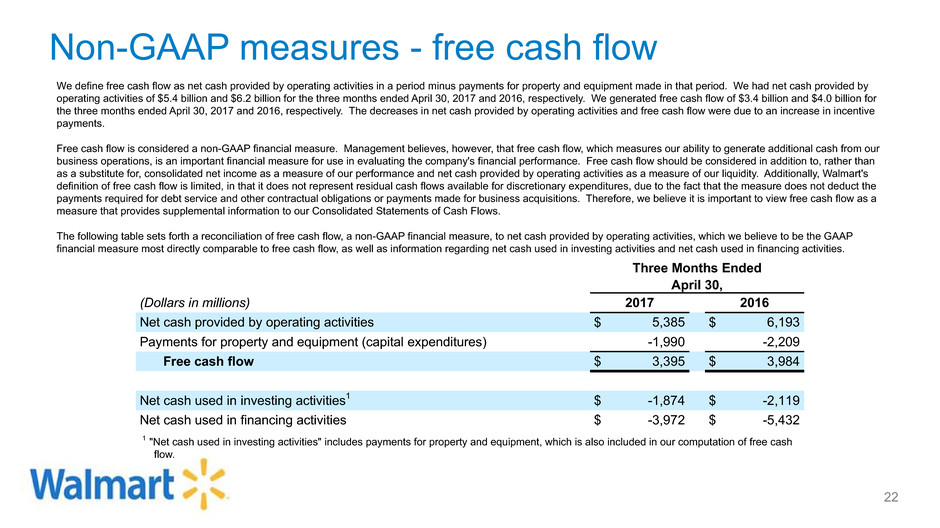
Non-GAAP measures - free cash flow
We define free cash flow as net cash provided by operating activities in a period minus payments for property and equipment made in that period. We had net cash provided by
operating activities of $5.4 billion and $6.2 billion for the three months ended April 30, 2017 and 2016, respectively. We generated free cash flow of $3.4 billion and $4.0 billion for
the three months ended April 30, 2017 and 2016, respectively. The decreases in net cash provided by operating activities and free cash flow were due to an increase in incentive
payments.
Free cash flow is considered a non-GAAP financial measure. Management believes, however, that free cash flow, which measures our ability to generate additional cash from our
business operations, is an important financial measure for use in evaluating the company's financial performance. Free cash flow should be considered in addition to, rather than
as a substitute for, consolidated net income as a measure of our performance and net cash provided by operating activities as a measure of our liquidity. Additionally, Walmart's
definition of free cash flow is limited, in that it does not represent residual cash flows available for discretionary expenditures, due to the fact that the measure does not deduct the
payments required for debt service and other contractual obligations or payments made for business acquisitions. Therefore, we believe it is important to view free cash flow as a
measure that provides supplemental information to our Consolidated Statements of Cash Flows.
The following table sets forth a reconciliation of free cash flow, a non-GAAP financial measure, to net cash provided by operating activities, which we believe to be the GAAP
financial measure most directly comparable to free cash flow, as well as information regarding net cash used in investing activities and net cash used in financing activities.
Three Months Ended
April 30,
(Dollars in millions) 2017 2016
Net cash provided by operating activities $ 5,385 $ 6,193
Payments for property and equipment (capital expenditures) -1,990 -2,209
Free cash flow $ 3,395 $ 3,984
Net cash used in investing activities1 $ -1,874 $ -2,119
Net cash used in financing activities $ -3,972 $ -5,432
1 "Net cash used in investing activities" includes payments for property and equipment, which is also included in our computation of free cash
flow.
22
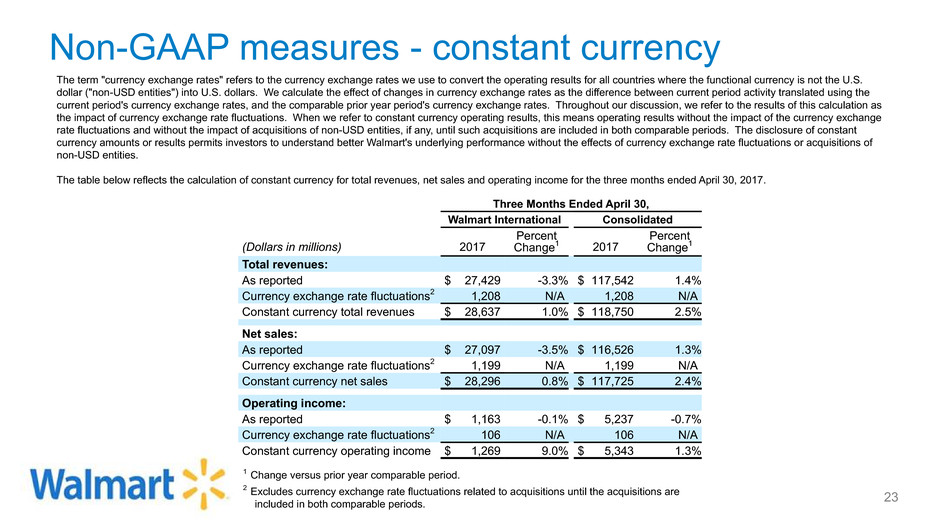
1 Change versus prior year comparable period.
2 Excludes currency exchange rate fluctuations related to acquisitions until the acquisitions are
included in both comparable periods.
Non-GAAP measures - constant currency
23
The term "currency exchange rates" refers to the currency exchange rates we use to convert the operating results for all countries where the functional currency is not the U.S.
dollar ("non-USD entities") into U.S. dollars. We calculate the effect of changes in currency exchange rates as the difference between current period activity translated using the
current period's currency exchange rates, and the comparable prior year period's currency exchange rates. Throughout our discussion, we refer to the results of this calculation as
the impact of currency exchange rate fluctuations. When we refer to constant currency operating results, this means operating results without the impact of the currency exchange
rate fluctuations and without the impact of acquisitions of non-USD entities, if any, until such acquisitions are included in both comparable periods. The disclosure of constant
currency amounts or results permits investors to understand better Walmart's underlying performance without the effects of currency exchange rate fluctuations or acquisitions of
non-USD entities.
The table below reflects the calculation of constant currency for total revenues, net sales and operating income for the three months ended April 30, 2017.
Three Months Ended April 30,
Walmart International Consolidated
(Dollars in millions) 2017
Percent
Change1 2017
Percent
Change1
Total revenues:
As reported $ 27,429 -3.3% $ 117,542 1.4%
Currency exchange rate fluctuations2 1,208 N/A 1,208 N/A
Constant currency total revenues $ 28,637 1.0% $ 118,750 2.5%
Net sales:
As reported $ 27,097 -3.5% $ 116,526 1.3%
Currency exchange rate fluctuations2 1,199 N/A 1,199 N/A
Constant currency net sales $ 28,296 0.8% $ 117,725 2.4%
Operating income:
As reported $ 1,163 -0.1% $ 5,237 -0.7%
Currency exchange rate fluctuations2 106 N/A 106 N/A
Constant currency operating income $ 1,269 9.0% $ 5,343 1.3%

Non-GAAP measures - fuel impact
The net sales and operating income of Sam's Club for the three months ended April 30, 2017, the percentage changes in
those financial measures from the respective comparable prior year period, comparable sales of Sam's Club and Walmart
U.S. for the 13-week period ended April 28, 2017 and projected comparable sales for the 13-week period ending July 28,
2017, in each case calculated by excluding fuel sales for such periods, are non-GAAP financial measures. We believe the
net sales and operating income for the three months ended April 30, 2017, the percentage changes in those financial
measures from the respective comparable prior year period, comparable sales for the 13-week period ended April 28, 2017,
and projected comparable sales for the 13-week period ending July 28, 2017, in each case calculated by including fuel sales
for such period, are, respectively, the financial measures computed in accordance with GAAP most directly comparable to
the non-GAAP financial measures described above.
We believe that the presentation of the non-GAAP financial measures with respect to Sam’s Club and Walmart U.S.
described above provides useful information to investors regarding Walmart’s financial condition and results of operations
because that information permits investors to understand the effect of fuel sales, which are affected by the volatility of fuel
prices, on Sam's Club's net sales and operating income and on Sam's Club's and Walmart U.S.'s comparable sales for the
periods presented.
24
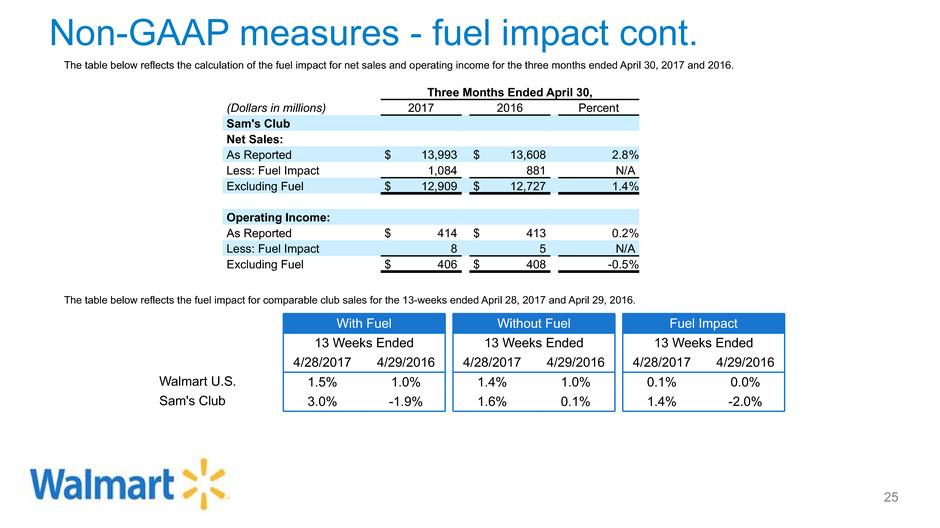
Non-GAAP measures - fuel impact cont.
The table below reflects the calculation of the fuel impact for net sales and operating income for the three months ended April 30, 2017 and 2016.
Three Months Ended April 30,
(Dollars in millions) 2017 2016 Percent
Sam's Club
Net Sales:
As Reported $ 13,993 $ 13,608 2.8%
Less: Fuel Impact 1,084 881 N/A
Excluding Fuel $ 12,909 $ 12,727 1.4%
Operating Income:
As Reported $ 414 $ 413 0.2%
Less: Fuel Impact 8 5 N/A
Excluding Fuel $ 406 $ 408 -0.5%
The table below reflects the fuel impact for comparable club sales for the 13-weeks ended April 28, 2017 and April 29, 2016.
With Fuel Without Fuel Fuel Impact
13 Weeks Ended 13 Weeks Ended 13 Weeks Ended
4/28/2017 4/29/2016 4/28/2017 4/29/2016 4/28/2017 4/29/2016
Walmart U.S. 1.5% 1.0% 1.4% 1.0% 0.1% 0.0%
Sam's Club 3.0% -1.9% 1.6% 0.1% 1.4% -2.0%
25
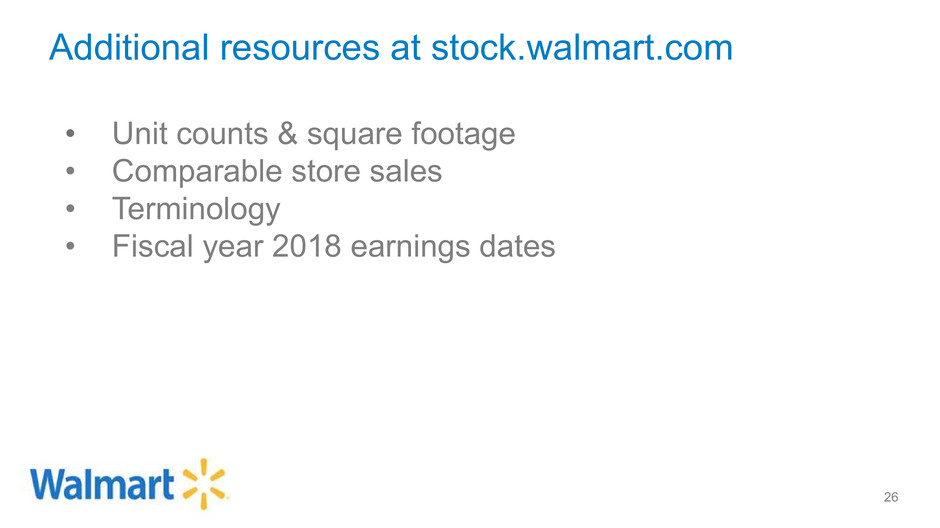
• Unit counts & square footage
• Comparable store sales
• Terminology
• Fiscal year 2018 earnings dates
Additional resources at stock.walmart.com
26
